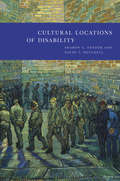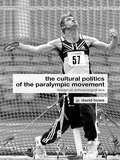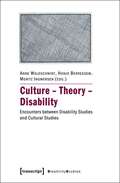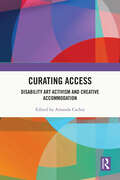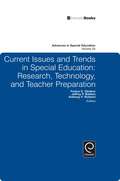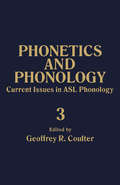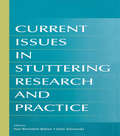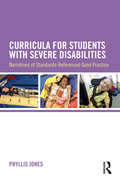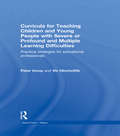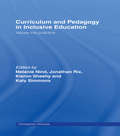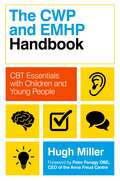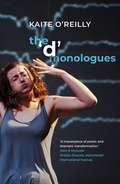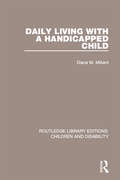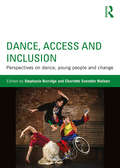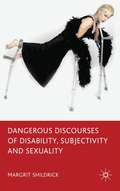- Table View
- List View
Cultural Locations of Disability
by David T. Mitchell Sharon L. SnyderIn Cultural Locations of Disability, Sharon L. Snyder and David T. Mitchell trace how disabled people came to be viewed as biologically deviant. The eugenics era pioneered techniques that managed "defectives" through the application of therapies, invasive case histories, and acute surveillance techniques, turning disabled persons into subjects for a readily available research pool. In its pursuit of normalization, eugenics implemented disability regulations that included charity systems, marriage laws, sterilization, institutionalization, and even extermination. Enacted in enclosed disability locations, these practices ultimately resulted in expectations of segregation from the mainstream, leaving today's disability politics to focus on reintegration, visibility, inclusion, and the right of meaningful public participation. Snyder and Mitchell reveal cracks in the social production of human variation as aberrancy. From our modern obsessions with tidiness and cleanliness to our desire to attain perfect bodies, notions of disabilities as examples of human insufficiency proliferate. These disability practices infuse more general modes of social obedience at work today. Consequently, this important study explains how disabled people are instrumental to charting the passage from a disciplinary society to one based upon regulation of the self.
Cultural Locations Of Disability
by Sharon L. Snyder David T. MitchellIn Cultural Locations of Disability, Sharon L. Snyder and David T. Mitchell trace how disabled people came to be viewed as biologically deviant. The eugenics era pioneered techniques that managed "defectives" through the application of therapies, invasive case histories, and acute surveillance techniques, turning disabled persons into subjects for a readily available research pool. In its pursuit of normalization, eugenics implemented disability regulations that included charity systems, marriage laws, sterilization, institutionalization, and even extermination. Enacted in enclosed disability locations, these practices ultimately resulted in expectations of segregation from the mainstream, leaving today's disability politics to focus on reintegration, visibility, inclusion, and the right of meaningful public participation. Snyder and Mitchell reveal cracks in the social production of human variation as aberrancy. From our modern obsessions with tidiness and cleanliness to our desire to attain perfect bodies, notions of disabilities as examples of human insufficiency proliferate. These disability practices infuse more general modes of social obedience at work today. Consequently, this important study explains how disabled people are instrumental to charting the passage from a disciplinary society to one based upon regulation of the self.
The Cultural Politics of the Paralympic Movement: Through an Anthropological Lens (Routledge Critical Studies in Sport)
by David HoweDo the Paralympic Games empower the disability sport community? Like many other contemporary sporting institutions, the Paralympic Games have made the transition from pastime to spectacle, and the profile of athletes with disabilities has been increased as a result. This book reviews the current status of the Paralympics and challenges the mainstream assumption that the Games are a vehicle for empowerment of the disabled community. Using ethnographic methods unique in this area of study, P. David Howe has undertaken an innovative and critical examination of the social, political and economic processes shaping the Paralympic Movement. In The Cultural Politics of the Paralympic Movement he presents his findings and offers a new insight into the relationship between sport, the body and the culture of disability. In doing so he has produced the most comprehensive and radical text about high performance sport for the disabled yet published. P. David Howe is Lecturer in the Sociology of Sport at Loughborough University. He is also a four-time Paralympian and former Athlete’s Representative to the International Paralympic Committee.
The Cultural Politics of the Paralympic Movement: Through an Anthropological Lens (Routledge Critical Studies in Sport)
by David HoweDo the Paralympic Games empower the disability sport community? Like many other contemporary sporting institutions, the Paralympic Games have made the transition from pastime to spectacle, and the profile of athletes with disabilities has been increased as a result. This book reviews the current status of the Paralympics and challenges the mainstream assumption that the Games are a vehicle for empowerment of the disabled community. Using ethnographic methods unique in this area of study, P. David Howe has undertaken an innovative and critical examination of the social, political and economic processes shaping the Paralympic Movement. In The Cultural Politics of the Paralympic Movement he presents his findings and offers a new insight into the relationship between sport, the body and the culture of disability. In doing so he has produced the most comprehensive and radical text about high performance sport for the disabled yet published. P. David Howe is Lecturer in the Sociology of Sport at Loughborough University. He is also a four-time Paralympian and former Athlete’s Representative to the International Paralympic Committee.
Culture - Theory - Disability: Encounters between Disability Studies and Cultural Studies (Disability Studies. Körper - Macht - Differenz #10)
by Anne Waldschmidt Hanjo Berressem Moritz IngwersenWhich theoretical and methodological approaches of contemporary cultural criticism resonate within the field of disability studies? What can cultural studies gain by incorporating disability more fully into its toolbox for critical analysis? Culture - Theory - Disability features contributions by leading international cultural disability studies scholars which are complemented with a diverse range of responses from across the humanities spectrum. This essential volume encourages the problematization of disability in connection with critical theories of literary and cultural representation, aesthetics, politics, science and technology, sociology, and philosophy. It includes essays by Lennard J. Davis, Rosemarie Garland-Thomson, Dan Goodley, Robert McRuer and Margrit Shildrick.
Curating Access: Disability Art Activism and Creative Accommodation
by Amanda CachiaThis book is an interdisciplinary collection of twenty-four essays which critically examine contemporary exhibitions and artistic practices that focus on conceptual and creative aspects of access. Oftentimes exhibitions tack on access once the artwork has already been executed and ready to be installed in the museum or gallery. But what if the artists were to ponder access as an integral and critical part of their artwork? Can access be creative and experimental? And furthermore, can the curator also fold access into their practice, while working collaboratively with artists, considering it as a theoretical and practical generative force that seeks to make an exhibition more engaging for a wider diversity of audiences? This volume includes essays by a growing number of artists, curators, and scholars who ponder these ideas of ad-hoc, experimental and underground approaches within exhibition-making and artistic practices. It considers how, through these nascent exhibition models and art practices, enhanced experiences of access in the museum can be a shared responsibility amongst museum workers, curators, and artists, in tandem with the public, so that access becomes a zone of intellectual and creative "accommodation," rather than strictly a discourse on policy. The book provides innovative case studies which provide a template for how access might be implemented by individuals, artists, curators, museum administrators and educators given the growing need to offer as many modalities of access as possible within cultural institutions. This book shows that anyone can be a curator of access and demonstrates how to approach access in a way that goes beyond protocol and policy. It will thus be of interest to students and scholars engaged in the study of museums, art history and visual culture, disability, culture, and communication.
Curating Access: Disability Art Activism and Creative Accommodation
by Amanda CachiaThis book is an interdisciplinary collection of twenty-four essays which critically examine contemporary exhibitions and artistic practices that focus on conceptual and creative aspects of access. Oftentimes exhibitions tack on access once the artwork has already been executed and ready to be installed in the museum or gallery. But what if the artists were to ponder access as an integral and critical part of their artwork? Can access be creative and experimental? And furthermore, can the curator also fold access into their practice, while working collaboratively with artists, considering it as a theoretical and practical generative force that seeks to make an exhibition more engaging for a wider diversity of audiences? This volume includes essays by a growing number of artists, curators, and scholars who ponder these ideas of ad-hoc, experimental and underground approaches within exhibition-making and artistic practices. It considers how, through these nascent exhibition models and art practices, enhanced experiences of access in the museum can be a shared responsibility amongst museum workers, curators, and artists, in tandem with the public, so that access becomes a zone of intellectual and creative "accommodation," rather than strictly a discourse on policy. The book provides innovative case studies which provide a template for how access might be implemented by individuals, artists, curators, museum administrators and educators given the growing need to offer as many modalities of access as possible within cultural institutions. This book shows that anyone can be a curator of access and demonstrates how to approach access in a way that goes beyond protocol and policy. It will thus be of interest to students and scholars engaged in the study of museums, art history and visual culture, disability, culture, and communication.
Current Issues and Trends in Special Education: Research, Technology, and Teacher Preparation (Advances in Special Education #20)
by Festus E. Obiakor Jeffrey P. Bakken Anthony F. Rotatori"This is the second of two themed volumes addressing current issues and trends in special education. Volume 20 covers research, technology, and teacher preparation whilst volume 19 covered identification, assessment and instruction. The field of special education constantly changes as a result of legislation, new instructional formats and current research investigations. It can be difficult for general and special educators, school counselors and psychologists, administrators and practicing clinicians to keep up with these changes and be current in all areas relating to special education. The special education literature knowledge base should reflect these changes; however, there is no current resource that effectively and comprehensively does this. The purpose of "Current Issues and Trends in Special Education" is to fill this void, providing chapters written by active researchers and practitioners in their respective areas.
Current Issues in ASL Phonology: Phonetics and Phonology, Vol. 3
by Geoffrey R. CoulterPhonetics and Phonology, Volume 3: Current Issues in ASL Phonology deals with theoretical issues in the phonology of ASL (American Sign Language), the signed language of the American Deaf. These issues range from the overall architecture of phonological theory to particular proposals such as the nature of syllables and the reality of underlying "dynamic" or "contour" elements. The seemingly universal preference, CV (consonant-vowel) as opposed to VC (vowel-consonant) syllable structure, is also discussed.Comprised of 14 chapters, this volume begins with some general background on ASL and on the community in which it is used. It then looks at secondary licensing and the nature of constraints on the non-dominant hand in ASL; underspecification in ASL handshape contours; and the nature of ASL and the development of ASL linguistics. The applicability of the notion of "phonology" to a signed language and the sort of questions that can be explored about the parallelisms between signed and spoken linguistic systems are also considered. Later chapters focus on the linearization of phonological tiers in ASL; phonological segmentation in sign and speech; two models of segmentation in ASL; and sonority and syllable structure in ASL. The book also examines phrase-level prosody in ASL before concluding with an analysis of linguistic expression and its relation to modality. This monograph will appeal to phonologists who work on both signed and spoken languages, and to other cognitive scientists interested in the nature of abstract articulatory representations in human language.
Current Issues in Stuttering Research and Practice
by Nan Bernstein Ratner John TetnowskiThis state-of-the art volume is a follow-up to the 1999 publication, Stuttering Research and Practice: Bridging the Gap, edited by Nan Ratner and E. Charles Healey. Like its predecessor, the current book is an edited collection of the presentations from the American Speech-Language-Hearing Association’s Annual Leadership Conference in Fluency and Fluency Disorders. Among the topics covered are evidence-based practice, impact of the self-help and support groups, meta-analyses of selected assessment and intervention programs, current theories of stuttering, and the predicted path of stuttering intervention in the future. The authoritative representation of contributors offers the reader the most up to date presentation of fluency issues, with a special emphasis placed on the practical clinical implications of fluency assessment, treatment, and evolving theories of the disorder. The book is written for fluency specialists and graduate students in programs of fluency disorders. It will also be valuable for the clinicians who wish to upgrade their skills in treating fluency disorders.
Current Issues in Stuttering Research and Practice
by Nan Bernstein Ratner John A. TetnowskiThis state-of-the art volume is a follow-up to the 1999 publication, Stuttering Research and Practice: Bridging the Gap, edited by Nan Ratner and E. Charles Healey. Like its predecessor, the current book is an edited collection of the presentations from the American Speech-Language-Hearing Association’s Annual Leadership Conference in Fluency and Fluency Disorders. Among the topics covered are evidence-based practice, impact of the self-help and support groups, meta-analyses of selected assessment and intervention programs, current theories of stuttering, and the predicted path of stuttering intervention in the future. The authoritative representation of contributors offers the reader the most up to date presentation of fluency issues, with a special emphasis placed on the practical clinical implications of fluency assessment, treatment, and evolving theories of the disorder. The book is written for fluency specialists and graduate students in programs of fluency disorders. It will also be valuable for the clinicians who wish to upgrade their skills in treating fluency disorders.
Curricula for Students with Severe Disabilities: Narratives of Standards-Referenced Good Practice
by Phyllis JonesStudents with severe disabilities comprise 2 percent of the population of learners who are impacted by intellectual, communicative, social, emotional, physical, sensory and medical issues. Increasingly, however, teachers are required to meet the challenges of creating a pedagogical balance between an individual student's strengths, needs and preferences, and core academic curricula. The need to embrace the current initiative of curriculum state standards in the debate of curricula relevance, breadth, balance and depth for students with severe disabilities is not just timely—it contributes to the evolving debate of what constitutes an appropriate curriculum for severely disabled learners. Curricula for Students with Severe Disabilities supports the development of greater understandings of the role that state curriculum standards play in the pedagogical decision-making for students with severe intellectual disabilities. The book first discusses the nature and needs of these students, the curriculum for this group of learners and the recent contributions of state curriculum standards, before presenting narratives of real classrooms, teachers and students who have meaningfully integrated state curriculum standards at the kindergarten, elementary and high school levels.
Curricula for Students with Severe Disabilities: Narratives of Standards-Referenced Good Practice
by Phyllis JonesStudents with severe disabilities comprise 2 percent of the population of learners who are impacted by intellectual, communicative, social, emotional, physical, sensory and medical issues. Increasingly, however, teachers are required to meet the challenges of creating a pedagogical balance between an individual student's strengths, needs and preferences, and core academic curricula. The need to embrace the current initiative of curriculum state standards in the debate of curricula relevance, breadth, balance and depth for students with severe disabilities is not just timely—it contributes to the evolving debate of what constitutes an appropriate curriculum for severely disabled learners. Curricula for Students with Severe Disabilities supports the development of greater understandings of the role that state curriculum standards play in the pedagogical decision-making for students with severe intellectual disabilities. The book first discusses the nature and needs of these students, the curriculum for this group of learners and the recent contributions of state curriculum standards, before presenting narratives of real classrooms, teachers and students who have meaningfully integrated state curriculum standards at the kindergarten, elementary and high school levels.
Curricula for Teaching Children and Young People with Severe or Profound and Multiple Learning Difficulties: Practical strategies for educational professionals (nasen spotlight)
by Peter Imray Viv HinchcliffeCurricula for Teaching Children and Young People with Severe or Profound and Multiple Learning Difficulties offers a range of compelling arguments for a distinct and separate pedagogical approach to the learning needs of the most educationally challenging pupils. This book, written in accessible, common sense and non-academic language, provides an easy-to-follow alternative curriculum specifically designed to enhance and enrich the learning of children with profound and multiple learning difficulties. Chapter by chapter, guidelines and support are offered in key curriculum areas, some of which include: Cognition Language, Literacy and Communication Mathematical Physical Sensory Creative Care Play Problem solving. This highly practical resource is essential reading for any educational professional, parents, school governors, teachers, teaching assistants, therapists and indeed anyone involved with maximising the educational opportunities of those with profound learning difficulties.
Curricula for Teaching Children and Young People with Severe or Profound and Multiple Learning Difficulties: Practical strategies for educational professionals (nasen spotlight)
by Peter Imray Viv HinchcliffeCurricula for Teaching Children and Young People with Severe or Profound and Multiple Learning Difficulties offers a range of compelling arguments for a distinct and separate pedagogical approach to the learning needs of the most educationally challenging pupils. This book, written in accessible, common sense and non-academic language, provides an easy-to-follow alternative curriculum specifically designed to enhance and enrich the learning of children with profound and multiple learning difficulties. Chapter by chapter, guidelines and support are offered in key curriculum areas, some of which include: Cognition Language, Literacy and Communication Mathematical Physical Sensory Creative Care Play Problem solving. This highly practical resource is essential reading for any educational professional, parents, school governors, teachers, teaching assistants, therapists and indeed anyone involved with maximising the educational opportunities of those with profound learning difficulties.
Curriculum and Pedagogy in Inclusive Education: Values into practice
by Melanie Nind Jonathan Rix Kieron Sheehy Katy SimmonsWhile activists, politicians and policy-makers grapple with the big picture, teachers and learners are making inclusion happen in their day-to-day lives. This unique text shows the importance and reality of curriculum and pedagogy in developing inclusive practice in a range of settings.Bringing together an exemplary collection of key articles, this Reader provides ways of thinking about inclusive curricula and pedagogy as starting points for possible action, as wel as:* illustrating how teachers can get education right or wrong for diverse learners depending on the pedagogical decisions they make;* discussing the role of the ordinary, special and inclusive pedagogy;* showing examples of teaching that elicits genuine participation and active learning;* providing case studies, and lessons from learners about what makes good teaching for them.Curriculum and Pedagogy in Inclusive Education will be inspirational reading for anyone with an interest in making inclusion happen.
Curriculum and Pedagogy in Inclusive Education: Values into practice
by Melanie Nind Jonathan Rix Kieron Sheehy Katy SimmonsWhile activists, politicians and policy-makers grapple with the big picture, teachers and learners are making inclusion happen in their day-to-day lives. This unique text shows the importance and reality of curriculum and pedagogy in developing inclusive practice in a range of settings.Bringing together an exemplary collection of key articles, this Reader provides ways of thinking about inclusive curricula and pedagogy as starting points for possible action, as wel as:* illustrating how teachers can get education right or wrong for diverse learners depending on the pedagogical decisions they make;* discussing the role of the ordinary, special and inclusive pedagogy;* showing examples of teaching that elicits genuine participation and active learning;* providing case studies, and lessons from learners about what makes good teaching for them.Curriculum and Pedagogy in Inclusive Education will be inspirational reading for anyone with an interest in making inclusion happen.
The CWP and EMHP Handbook: CBT Essentials with Children and Young People
by Hugh MillerAs an Education Mental Health Practitioner (EMHP) or Children's Wellbeing Practitioner (CWP), you have to think on your feet, manage a caseload, deal with emotional distress and try and not get indigestion as you cram down a sandwich on your way to your next session.This down-to-earth survival guide helps trainees and newly qualified practitioners cope with the stressful demands of these new and challenging roles. Full of case examples and practical tools and strategies, this book will give you the confidence to assess, set goals, and deliver effective interventions for anxiety and depression. It also provides invaluable support on tricky topics such as disclosures of risk and safeguarding issues, working effectively with parents, dealing with resistance and conflict, caring for yourself, and signposting when a situation is outside the remit of your role.
The 'd' Monologues (Oberon Modern Playwrights)
by Kaite O'ReillyFrom biting satire to crip’ pride, observational comedy to poignant revelations of life in contemporary Britain and beyond, these texts challenge and subvert ingrained preconceptions of difference and disability, relishing all the possibilities of human variety.An atypical body of work – solo, choral and ensemble monologues for D/deaf and disabled performers, inspired by lived experience.
Daily Living with a Handicapped Child (Routledge Library Editions: Children and Disability)
by Diana M. MillardFirst published in 1984, this book focuses on the support and reassurance needed by parents of children with handicaps. It provides a practical guide in relation to daily care and is equally as relevant to professionals, therapists, teachers, doctors and psychologists who must advise parents. Written by an Occupational Therapist, the book highlights the need to make such children as independent as possible and gives advice on care of a special baby, modifications to the home environment, the needs of a child with a physical handicap, problems of educational handicap, and the place of a child in the family and community.
Daily Living with a Handicapped Child (Routledge Library Editions: Children and Disability #11)
by Diana M. MillardFirst published in 1984, this book focuses on the support and reassurance needed by parents of children with handicaps. It provides a practical guide in relation to daily care and is equally as relevant to professionals, therapists, teachers, doctors and psychologists who must advise parents. Written by an Occupational Therapist, the book highlights the need to make such children as independent as possible and gives advice on care of a special baby, modifications to the home environment, the needs of a child with a physical handicap, problems of educational handicap, and the place of a child in the family and community.
Dance, Access and Inclusion: Perspectives on Dance, Young People and Change
by Stephanie Burridge Charlotte Svendler NielsenThe arts have a crucial role in empowering young people with special needs through diverse dance initiatives. Inclusive pedagogy that integrates all students in rich, equitable and just dance programmes within education frameworks is occurring alongside enabling projects by community groups and in the professional dance world where many high-profile choreographers actively seek opportunities to work across diversity to inspire creativity. Access and inclusion is increasingly the essence of projects for disenfranchised and traumatised youth who find creative expression, freedom and hope through dance. This volume foregrounds dance for young people with special needs and presents best practice scenarios in schools, communities and the professional sphere. International perspectives come from Australia, Brazil, Cambodia, Canada, Denmark, Fiji, Finland, India, Indonesia, Jamaica, Japan, Malaysia, New Zealand, Norway, Papua New Guinea, Portugal, Singapore, South Africa, Spain, Taiwan, Timor Leste, the UK and the USA. Sections include: inclusive dance pedagogy equality, advocacy and policy changing practice for dance education community dance initiatives professional integrated collaborations
Dance, Access and Inclusion: Perspectives on Dance, Young People and Change
by Stephanie Burridge Charlotte Svendler NielsenThe arts have a crucial role in empowering young people with special needs through diverse dance initiatives. Inclusive pedagogy that integrates all students in rich, equitable and just dance programmes within education frameworks is occurring alongside enabling projects by community groups and in the professional dance world where many high-profile choreographers actively seek opportunities to work across diversity to inspire creativity. Access and inclusion is increasingly the essence of projects for disenfranchised and traumatised youth who find creative expression, freedom and hope through dance. This volume foregrounds dance for young people with special needs and presents best practice scenarios in schools, communities and the professional sphere. International perspectives come from Australia, Brazil, Cambodia, Canada, Denmark, Fiji, Finland, India, Indonesia, Jamaica, Japan, Malaysia, New Zealand, Norway, Papua New Guinea, Portugal, Singapore, South Africa, Spain, Taiwan, Timor Leste, the UK and the USA. Sections include: inclusive dance pedagogy equality, advocacy and policy changing practice for dance education community dance initiatives professional integrated collaborations
Dangerous Discourses Of Disability, Subjectivity And Sexuality
by Margrit ShildrickThis innovative and adventurous work, now in paperback, uses broadly feminist and postmodernist modes of analysis to explore what motivates damaging attitudes and practices towards disability. The book argues for the significance of the psycho-social imaginary and suggests a way forward in disability's queering of normative paradigms.
Dangerous Discourses Of Disability, Subjectivity And Sexuality (PDF)
by Margrit ShildrickThis innovative and adventurous work, now in paperback, uses broadly feminist and postmodernist modes of analysis to explore what motivates damaging attitudes and practices towards disability. The book argues for the significance of the psycho-social imaginary and suggests a way forward in disability's queering of normative paradigms.
